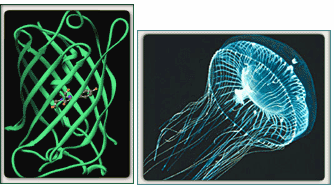We conduct experiments at our electrostatic storage ring ELISA. ELISA, built in 1997, is one of the first electrostatic ion storage rings in the world. Ions are orbiting by the aid of electric fields, which gives us essentially no mass limitation for the stored ions. Over the years we have developed laser-based techniques to study photo absorption of gas-phase chromophore ions in ELISA. Publications are found elsewhere on this home page. A particular important case is the GFP chromophore. Other systems count Schiff-base retinal, azobenzene, and chlorophylls.

The Green Fluorescent Protein (GFP) with the buried chromophore inside. The protein is from the Jellyfish called Aequorea Victoria.
We are combining several advanced experimental techniques to obtain new information on the spectroscopic properties of gas-phase molecules. The electrospray (ESI) ionization technique is applied to produce gas-phase species without breaking the molecules apart. A special ion-trap technique is applied which allows us to accumulate an appreciable amount of ions. The ions are then, as a bunch, sent into the ion storage ring. Here photo-absorption measurements are performed under vacuum conditions with pulsed, tunable lasers. Clearly, the gas-phase measurements serve as the reference, which may be used to test ab initio molecular calculations. In solvents, there may be strong shifts of the absorption maximum due to for example polar and hydrogen bonding, and counter-ion interactions. We are looking at effects of specific perturbations - like external charges and attachment of polar molecules.
One of the aims of our studies is to gain information about perturbations in proteins and we are synthesizing new chromophore molecules to study the dependence of such interactions on the structure of the chromophore. The fact that we are able to make new molecules and study their intrinsic properties may help us to understand photo-sensing proteins. We are in particular interested in the atomic scale perturbations on retinal, which form the basis of color vision.
We also study the excited-state dynamics in real-time by femtosecond pump-probe techniques. A TOPAS laser allows us to work at a variety of wavelengths. We use another storage-ring, called SAPHIRA, for this purpose. Here a pump photon brings the molecule into the excited state, the decay of which is followed by the action of a second probe pulse. By the technique, we have determined long (ns) fluorescence lifetimes, small energy-barriers in the excited state, and short (fs - ps) decay times associated with both autodetachment (electronic response) and internal conversion (nuclear response). To achieve full control over the internal state of the molecules we routinely cool the molecules to 6 K before injection and studies in the SAPHIRA ring.